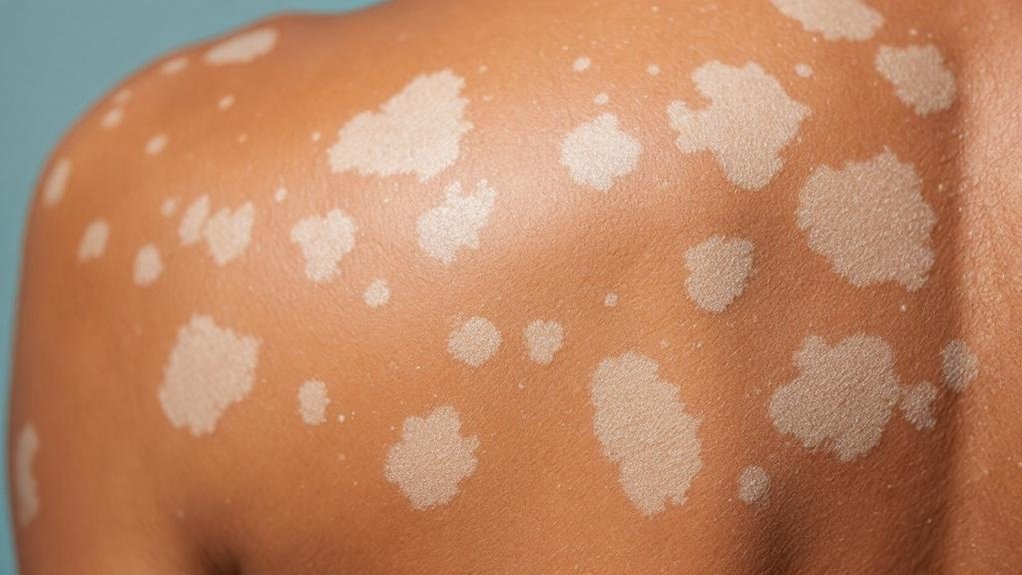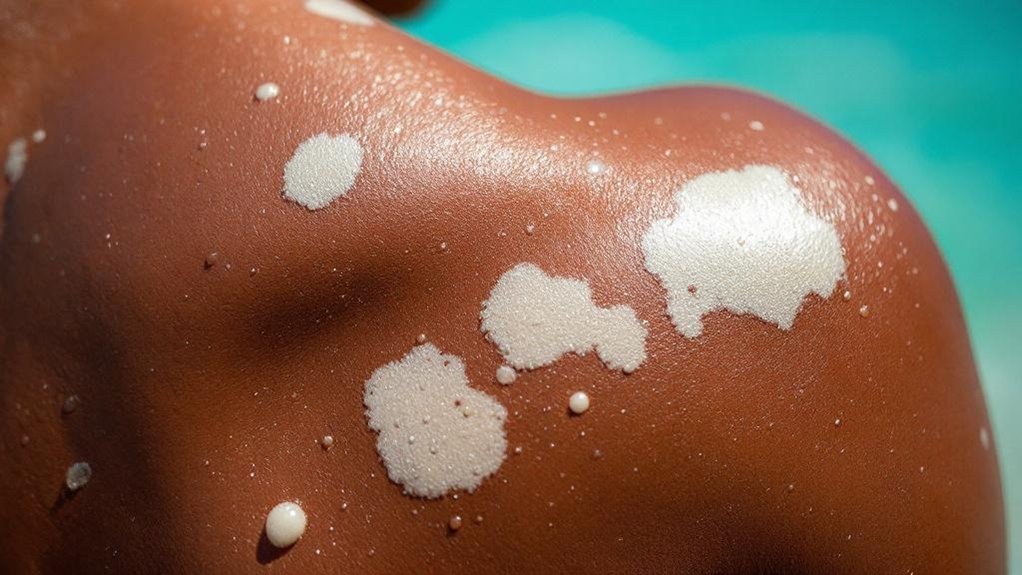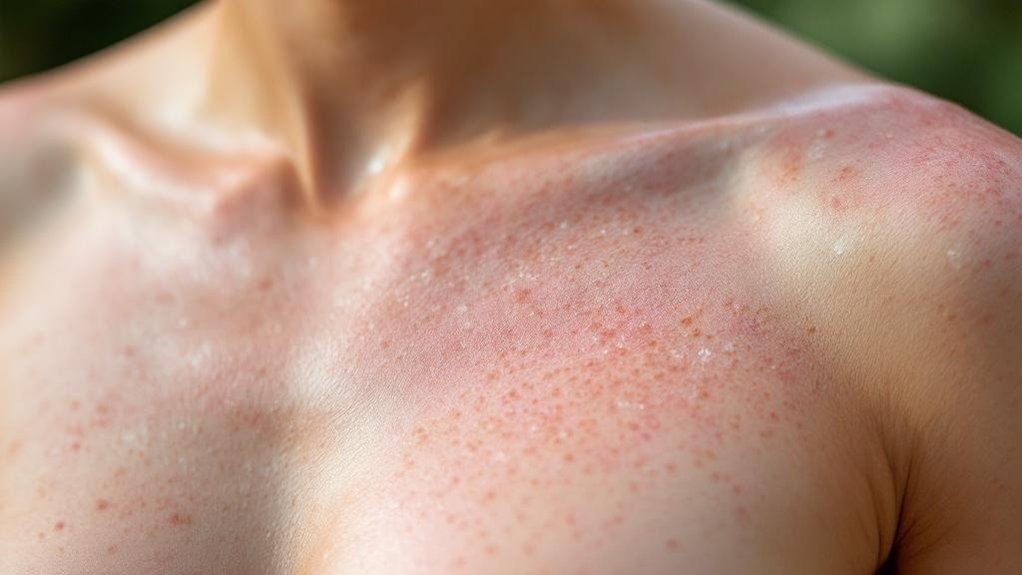Posted by: Skin And Cancer Institute in Uncategorized

Tinea versicolor is a common fungal infection caused by Malassezia yeast overgrowth, resulting in discolored patches on the skin. Symptoms include pink, tan, or brown spots that don’t tan uniformly. Treatment options range from over-the-counter antifungals like selenium sulfide and ketoconazole to prescription medications for persistent cases. Prevention involves keeping skin dry, using antifungal cleansers, and wearing loose clothing. The following thorough guide offers essential insights for effective management of this condition.
Key Takeaways
- Tinea versicolor causes discolored skin patches due to Malassezia yeast overgrowth, especially in humid conditions and on oily skin.
- Over-the-counter treatments include antifungal products containing selenium sulfide, ketoconazole, clotrimazole, or miconazole applied directly to affected areas.
- Prescription options like oral fluconazole may be necessary for persistent cases when topical treatments fail to resolve symptoms.
- Complete color normalization may take months even after successful treatment of the fungal infection itself.
- Prevention strategies include using antifungal cleansers monthly, wearing loose clothing, showering after sweating, and maintaining dry skin.
What Is Tinea Versicolor? Understanding the Fungal Infection

Tinea versicolor is a common fungal infection that affects the skin’s surface, causing patches of discoloration that may appear lighter or darker than surrounding skin. This condition is caused by an overgrowth of Malassezia yeast, which naturally lives on our skin but can multiply excessively under certain conditions.
We diagnose tinea versicolor through visual examination and sometimes through skin scrapings examined under a microscope. The condition affects all skin types, though the discoloration may be more noticeable in those with medium to dark complexions.
Symptoms typically include small, discolored patches that may be pink, tan, or brown, and can appear anywhere on the body but often concentrate on the back, chest, and shoulders. These patches may be slightly scaly and might become more pronounced after sun exposure.
Common Symptoms and How to Recognize Tinea Versicolor
Recognizing tinea versicolor early can help patients seek prompt treatment and prevent the condition from spreading further.
The most common symptoms include small, discolored patches on the skin that may appear lighter or darker than surrounding areas. These patches often develop on the chest, back, neck, and upper arms—areas with higher concentrations of sebaceous glands.
Patients typically notice that affected areas don’t tan uniformly, creating more noticeable contrast during summer months. The patches may be mildly itchy or scaly, especially when the body is warm.
These symptoms can considerably impact lifestyle and overall skin health, particularly during activities that expose affected areas.
If you’re experiencing unusual skin discoloration that persists despite regular hygiene practices, we recommend scheduling a dermatology consultation for proper diagnosis.
Causes and Risk Factors for Developing Tinea Versicolor

Malassezia, a yeast-like fungus naturally present on human skin, is the primary cause of tinea versicolor. When conditions are favorable, this normally harmless organism overgrows and causes the characteristic skin discoloration and scaling.
Several factors increase your risk of developing this condition. Excessive sweating, oily skin, and humid climates create the warm, moist environment where Malassezia thrives. We often see tinea versicolor worsen during summer months when these conditions intensify.
Hormonal changes, particularly during adolescence and pregnancy, can trigger outbreaks. Immunocompromised individuals face higher susceptibility. There’s also a genetic predisposition, as we observe this condition frequently runs in families.
Environmental triggers include prolonged sun exposure, certain oils, and skincare products that alter skin chemistry. Medications affecting your immune response may also contribute to fungal overgrowth.
Over-the-Counter Treatment Options for Mild Cases
For mild cases of tinea versicolor, we recommend starting with over-the-counter antifungal products containing ingredients like clotrimazole or miconazole.
Medicated cleansing bars formulated with zinc pyrithione can help control the yeast growth when used regularly during showering.
Selenium sulfide shampoos (such as Selsun Blue) applied to affected areas for 10 minutes before rinsing can also effectively reduce fungal populations when used daily for 1-2 weeks.
Topical Antifungal Products
When tinea versicolor presents with mild symptoms, over-the-counter topical antifungal products can effectively address the infection without requiring a prescription.
These topical solutions typically contain active ingredients such as selenium sulfide, ketoconazole, or clotrimazole, which work by disrupting fungal cell membranes and preventing reproduction of the Malassezia yeast.
For ideal antifungal effectiveness, we recommend applying these products to affected areas once or twice daily for at least two weeks, even if symptoms improve sooner. Many patients find that foam, cream, or lotion formulations are easier to apply than shampoos when treating the trunk and limbs.
While improvement may be noticeable within days, complete resolution of skin discoloration can take weeks to months as the skin naturally regains its normal pigmentation.
Medicated Cleansing Bars
Medicated cleansing bars represent an effective over-the-counter option for patients with mild tinea versicolor infections. These specialized products contain active antifungal ingredients like zinc pyrithione, selenium sulfide, or ketoconazole that target the Malassezia yeast responsible for the condition.
The medicated wash benefits include convenience of application during regular showering routines and gentle exfoliation that helps remove affected skin cells. For ideal results, we recommend leaving the lather on affected areas for 5-10 minutes before rinsing.
Among cleansing bar types, those with 2% zinc pyrithione are most commonly available and suitable for daily use. Selenium sulfide formulations offer stronger efficacy but may cause dryness.
We suggest using these bars consistently for 2-4 weeks, even after visible symptoms improve, to prevent recurrence of this common fungal infection.
Selenium Sulfide Shampoos
Selenium sulfide shampoos stand as a primary over-the-counter treatment option for tinea versicolor, offering patients an accessible solution beyond cleansing bars. These medicated formulations typically contain 1% or 2.5% selenium sulfide, with higher concentrations demonstrating increased effectiveness against the fungal infection.
We recommend applying the shampoo to affected areas and leaving it on the skin for 10 minutes before rinsing thoroughly. Ideal dosage frequency involves daily application for seven consecutive days, followed by maintenance treatment once or twice monthly to prevent recurrence. Many of our patients experience visible improvement within two weeks of consistent use.
For those with extensive or stubborn cases, we may suggest combining selenium sulfide shampoos with other treatments. Remember that these products may cause dryness or irritation, so moisturizing after treatment is advisable.
Prescription Treatments for Persistent Tinea Versicolor
For persistent cases of tinea versicolor that don’t respond to over-the-counter solutions, we recommend prescription-strength oral antifungal medications such as fluconazole or itraconazole. These systemic treatments work throughout the body to eliminate the fungal infection when topical approaches prove ineffective.
We also prescribe medicated shampoos containing higher concentrations of ketoconazole or selenium sulfide, which can be applied to affected areas and left on for specific periods to maximize treatment efficacy. Additionally, it’s important to consider that tinea versicolor is often caused by fungal infection and can be exacerbated by warm and humid environments.
Oral Antifungal Medications
When topical treatments prove insufficient for persistent or widespread tinea versicolor infections, oral antifungal medications may be prescribed by our dermatologists. These systemic medications work from within the body to eliminate the fungus causing tinea versicolor.
Common oral antifungals we prescribe include fluconazole, itraconazole, and ketoconazole. These medications demonstrate excellent oral antifungal effectiveness, often clearing stubborn infections with just a few doses. Treatment typically ranges from a single dose to a regimen spanning 1-2 weeks.
We carefully evaluate each patient before prescribing these medications, as potential side effects may include liver enzyme elevation, nausea, or medication interactions. Regular monitoring helps guarantee your safety throughout treatment.
Our team will discuss all potential benefits and risks, helping you join the many patients who’ve successfully overcome persistent tinea versicolor infections.
Medicated Shampoo Options
Medicated shampoos represent a cornerstone treatment option for persistent tinea versicolor infections, offering both therapeutic benefits and convenient application.
We recommend selenium sulfide (1-2.5%) and ketoconazole (1-2%) shampoos as first-line treatments, which effectively target the Malassezia yeast responsible for the condition.
For best results, apply these medicated shampoos to affected areas, including the scalp and body, leaving them on for 5-10 minutes before rinsing. Most patients see improvement after daily use for 1-2 weeks, followed by maintenance applications.
The key shampoo ingredients work by disrupting fungal cell membranes and inhibiting yeast proliferation while maintaining scalp health. Though skin may remain discolored for weeks after successful treatment, continued use of these specialized formulations will gradually restore normal pigmentation.
Natural Remedies and Lifestyle Changes That May Help

While prescription treatments are considered the most effective for tinea versicolor, several natural remedies and lifestyle modifications may complement medical therapy or provide relief for mild cases.
We recommend keeping the skin clean and dry, as the fungus thrives in warm, moist environments. Tea tree oil applied topically has antifungal properties that may help control symptoms.
Dietary adjustments focusing on probiotic-rich foods can support your skin’s microbiome balance. Proper skin hydration with non-comedogenic moisturizers prevents excessive oil production that fungi feed on.
Wearing breathable fabrics and changing out of sweaty clothes promptly can create an inhospitable environment for the fungus. Regular exfoliation may also help remove dead skin cells where the fungus resides.
Remember that while these approaches may provide relief, persistent or severe cases should be evaluated by our dermatologists.
Preventing Recurrence: Long-term Management Strategies
Tinea versicolor often recurs despite successful initial treatment, making long-term management an important component of care.
We recommend prophylactic use of antifungal shampoos or cleansers monthly, especially during warm months when recurrence is most common.
For thorough long-term care, patients should implement several lifestyle modifications: avoiding excessive heat and humidity, wearing loose-fitting clothing made of natural fibers, and promptly showering after sweating. Regular use of selenium sulfide or ketoconazole shampoo as a body wash can be particularly effective for prevention.
Some patients with frequent recurrences may benefit from scheduled maintenance therapy with oral antifungals once or twice monthly. Remember that even with proper management, the skin’s color may take months to normalize after the fungus is eliminated.
When should you consult a dermatologist about tinea versicolor?

We recommend seeking professional evaluation if over-the-counter treatments haven’t improved your condition within two to four weeks, or if symptoms worsen despite treatment.
A dermatologist consultation is important when tinea versicolor covers large areas of the body, causes significant discomfort, or frequently recurs. Patients with compromised immune systems should address skin concerns promptly, as fungal infections may spread more rapidly.
If you’re unsure whether your skin discoloration is tinea versicolor or another condition like vitiligo or pityriasis rosea, professional diagnosis is vital for appropriate treatment. Remember that persistent hypopigmentation can remain even after successful treatment of the infection.
A dermatologist can evaluate your specific situation and recommend personalized treatment options for your skin type and condition severity. Additionally, it is crucial to follow sun protection advice as certain skin conditions can be aggravated by sun exposure.
Frequently Asked Questions
Can Children Get Tinea Versicolor?
Yes, children can develop tinea versicolor. We often observe tinea symptoms like discolored patches on their skin. We recommend prevention tips including proper hygiene and avoiding excessive sweating to protect young patients.
Will Tinea Versicolor Affect My Tattoos?
Yes, tinea versicolor can affect tattoos by causing temporary discoloration. We recommend prompt treatment to minimize skin reactions and preserve tattoo integrity. Proper tattoo care during treatment is essential.
Is Tinea Versicolor Contagious Through Shared Clothing?
No, tinea versicolor isn’t typically contagious through shared clothing. The fungus causing this condition is naturally present on skin and requires specific conditions to overgrow, not simple transmission between individuals.
How Long Does Skin Discoloration Last After Treatment?
After treatment, skin discoloration from tinea versicolor typically resolves within 2-3 months as skin recovery progresses. We’ll monitor your pigmentation changes during follow-up visits to guarantee proper healing occurs.
Can Swimming Pools or Hot Tubs Trigger Tinea Versicolor?
Yes, swimming pools and hot tubs can trigger tinea versicolor. Pool chemicals may cause skin irritation that disrupts normal skin flora, creating conditions where this fungal infection thrives, especially in warm, humid environments.
Conclusion
At the Skin and Cancer Institute, we’re committed to helping you effectively manage tinea versicolor. This common fungal infection requires consistent treatment and preventive measures for lasting results. We’ve outlined various approaches, from topical antifungals to prescription options. Don’t hesitate to contact our dermatologists if your symptoms persist or worsen. With proper medical care, tinea versicolor can be successfully controlled.